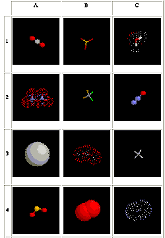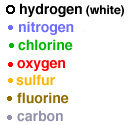The above linked molecular images are of naturally
occuring or man-made gases. They must be manipulated in order to
get a
correct view of the molecules. Complete the table for the
molecular images: 1) write a molecular formula for each, 2) name
each of the molecules, 3) provide the molar mass and estimate
whether the gas is more dense, less dense or about the same density
as air, and 4) identify each gas as being either a "natural" component
of the atmosphere or as a molecule predominately introduced into the
atmosphere by human (anthropogenic) activity. For example, 4A: SO2,
sulfur dioxide, 64 g/mol, likely more dense than air, anthropogenic:
introduced mainly by industrial smokestack operations.
The following image is of a microbe named Methanosarcina. It
has an interesting relationship
to greeenhouse gases.


